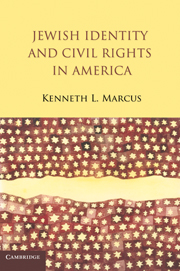Book contents
- Frontmatter
- Contents
- Acknowledgments
- Introduction
- 1 The Dilemma of Jewish Difference
- 2 The Jewish Question in Civil Rights Enforcement
- 3 The New Campus Anti-Semitism
- 4 Criticism
- 5 First Amendment Issues
- 6 Misunderstanding Jews and Jew Hatred
- 7 Institutional Resistance
- 8 The Originalist Approach
- 9 Scientific Theories
- 10 Social Perception
- 11 The Subjective Approach
- 12 Anti-Semitism as Harm to Racial Identity
- Conclusion
- Index
- References
12 - Anti-Semitism as Harm to Racial Identity
Published online by Cambridge University Press: 05 June 2012
- Frontmatter
- Contents
- Acknowledgments
- Introduction
- 1 The Dilemma of Jewish Difference
- 2 The Jewish Question in Civil Rights Enforcement
- 3 The New Campus Anti-Semitism
- 4 Criticism
- 5 First Amendment Issues
- 6 Misunderstanding Jews and Jew Hatred
- 7 Institutional Resistance
- 8 The Originalist Approach
- 9 Scientific Theories
- 10 Social Perception
- 11 The Subjective Approach
- 12 Anti-Semitism as Harm to Racial Identity
- Conclusion
- Index
- References
Summary
Anti-Semitic harassment can also been seen as racial discrimination because of the nature of the harm that it inflicts. Even the “new” anti-Semitism is “racial” (in other words, it is “discrimination because of … race”) in the sense that the nature of the injury that it inflicts is racial, regardless of the presence or absence of any particular motivating animus. Anti-Semitism harms the development of individual and group identity as perceived by both in-group and out-group members. This is to say, anti-Semitism adversely affects the development of Jewish racial identity, incorporating harmful stereotypes and defamations into the manner in which Jews are perceived and self-perceived.
In his famous formulation, philosopher Jean-Paul Sartre argued that “it is the anti-Semite who makes the Jew.” This argument has been controversial to those for whom it seems to deny the possibility of Jewish self-definition. With this caveat in mind, however, Sartre’s argument rings true in at least two important respects. First, while the anti-Semite may target actual Jews, the true object of the anti-Semite’s animus is a falsely constructed idea of Jewish identity that is only loosely related to Jewish reality. In other words, anti-Semites do not hate Jews for what Jews are but for what they are falsely believed to be. This observation led Brian Klug to reject the commonplace notion that anti-Semitism targets Jews as Jews. Instead, anti-Semitism is “hostility towards Jews as not Jews” because the “Jew” whom anti-Semites hate is not an actual Jew at all. “Thinking that Jews are really ‘Jews,’” Klug observes, “is precisely the core of anti-Semitism.”
- Type
- Chapter
- Information
- Jewish Identity and Civil Rights in America , pp. 173 - 187Publisher: Cambridge University PressPrint publication year: 2010



